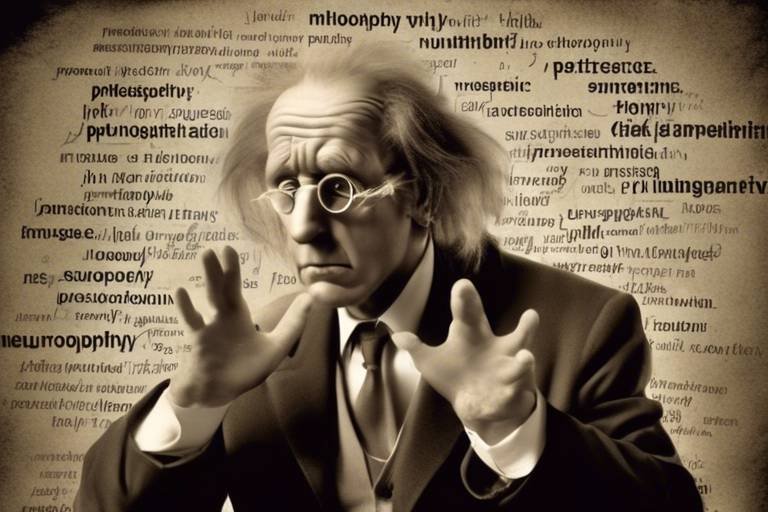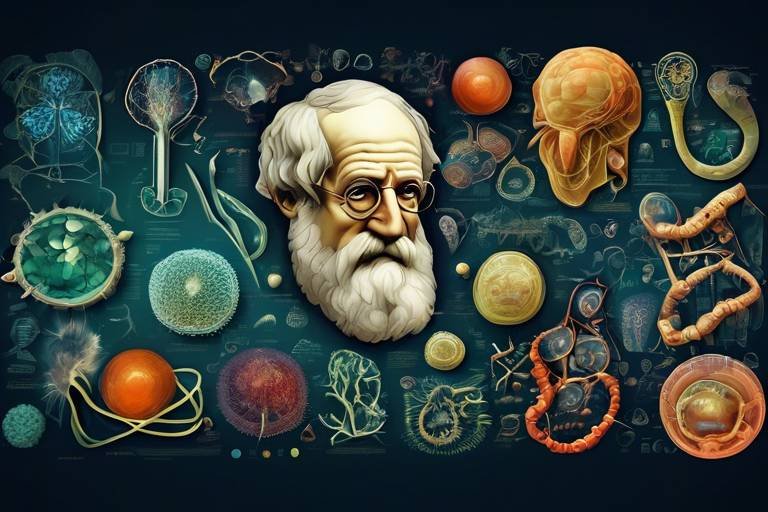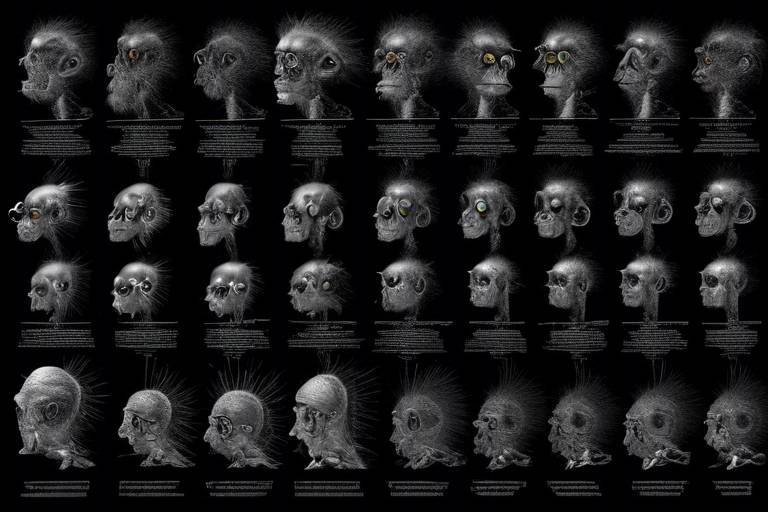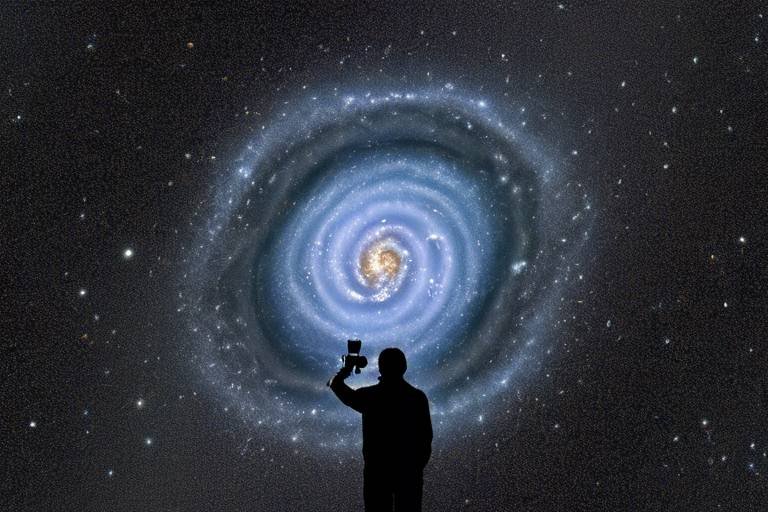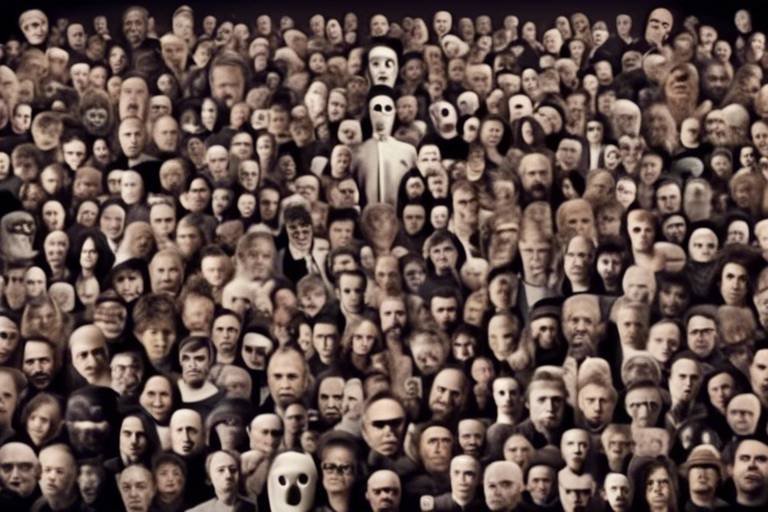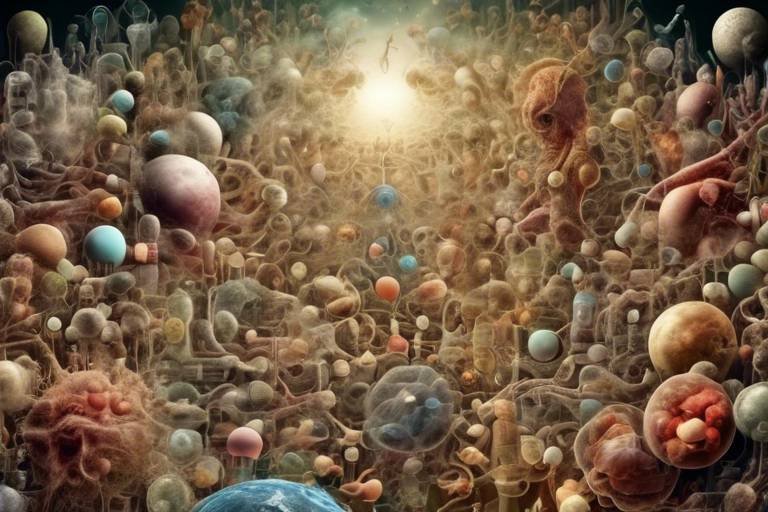String Theory – The Philosophical Interpretations
String theory is not just a complex mathematical framework; it’s a profound lens through which we can explore the very fabric of reality. Imagine, if you will, that everything in the universe—every particle, every force—is not merely a point in space but a tiny, vibrating string. This perspective shifts our understanding of existence and compels us to ponder the deeper questions of life, the universe, and everything in between. The implications of string theory extend far beyond physics, touching on philosophy, metaphysics, and even our existential musings about purpose and meaning. As we dive into this fascinating topic, we will uncover how string theory influences our understanding of reality, existence, and the universe's fundamental nature.
At its core, string theory proposes that the fundamental building blocks of the universe are not zero-dimensional points, but rather one-dimensional strings that vibrate at different frequencies. These vibrations determine the properties of particles, such as their mass and charge. This theory introduces the idea of multiple dimensions—more than the three spatial dimensions we experience daily. In fact, string theory suggests that there could be as many as ten or even eleven dimensions, with the extra dimensions being compactified or curled up in such a way that they are imperceptible to our senses. By attempting to unify the four fundamental forces of nature—gravity, electromagnetism, and the strong and weak nuclear forces—string theory aims to create a cohesive framework that explains everything from the tiniest subatomic particles to the vastness of the cosmos.
The introduction of multiple dimensions challenges our traditional understanding of space and time, prompting us to rethink the very nature of reality. If there are dimensions beyond our perception, what does that mean for our understanding of existence? It raises profound philosophical inquiries about how we perceive reality and the limitations of our knowledge. Are we merely scratching the surface of a much more complex universe? This question leads us to consider the concept of reality beyond perception.
String theory suggests that there exist realities that extend beyond human perception, which raises intriguing questions about the nature of knowledge. How can we claim to understand something that we cannot directly observe? This dilemma echoes the philosophical debates surrounding epistemology—the study of knowledge. If our senses are limited, then what does it mean to "know" something? This conundrum invites us to explore deeper into the realms of metaphysics, where questions about existence and the fundamental makeup of reality come to the forefront.
The implications of string theory extend into metaphysical discussions, particularly concerning causality and the nature of existence itself. If the universe is composed of vibrating strings in higher dimensions, what does that mean for our understanding of cause and effect? Traditional metaphysics often relies on a linear understanding of time and space, but string theory introduces a more intricate relationship between events. This complexity challenges our notions of determinism and randomness, suggesting that the universe may operate in ways we have yet to comprehend.
As we delve deeper into the philosophical implications of string theory, we encounter existential questions that probe the very essence of our existence. If we are but a small part of a potentially infinite multiverse, what is our purpose? Are we simply a product of random vibrations in the cosmos? These questions can feel overwhelming, yet they also inspire a sense of wonder. The idea that our lives might be part of a grander scheme invites us to reflect on our place in the universe and the meaning we derive from our experiences.
The philosophical intersections between string theory and quantum mechanics are equally fascinating. Both frameworks challenge our traditional concepts of determinism and randomness. In quantum mechanics, particles behave in ways that defy classical physics, suggesting a universe that is inherently unpredictable. String theory complements this by providing a more comprehensive understanding of how these particles interact in higher-dimensional spaces. Together, they paint a picture of a universe that is far more complex than we ever imagined, prompting us to reconsider our notions of reality and existence.
String theory also has significant implications for cosmology, particularly in understanding the origins of the universe. By examining how string theory interacts with cosmological theories, we gain insights into cosmic events and the fundamental nature of the universe itself. For instance, the Big Bang theory, which explains the universe's expansion from a singular point, can be reevaluated through the lens of string theory. This perspective not only deepens our understanding of the universe's beginnings but also opens up discussions about its future.
String theory offers potential explanations for the Big Bang, suggesting that the universe may have emerged from the collision of higher-dimensional objects known as branes. This not only provides a framework for understanding the initial conditions of the universe but also raises questions about what came before the Big Bang. Were there other universes? Did time itself exist? These questions challenge our understanding of time and existence, pushing the boundaries of what we consider possible.
Finally, string theory challenges traditional notions of time, possibly suggesting a more complex, non-linear understanding of temporal existence in the cosmos. Instead of viewing time as a straightforward progression from past to present to future, string theory invites us to consider time as a dimension that could be intertwined with the fabric of space in ways we have yet to understand. This perspective not only alters our understanding of the universe but also compels us to rethink our relationship with time itself.
- What is string theory? String theory is a theoretical framework in physics that posits that the fundamental particles of the universe are one-dimensional strings rather than zero-dimensional points.
- How does string theory relate to dimensions? String theory suggests the existence of multiple dimensions beyond the conventional three spatial dimensions, impacting our understanding of space and time.
- What are the philosophical implications of string theory? String theory raises profound questions about existence, reality, and our understanding of the universe, challenging traditional metaphysical and epistemological views.
- Can string theory explain the Big Bang? Yes, string theory offers potential explanations for the Big Bang, suggesting that the universe may have originated from higher-dimensional interactions.

The Basics of String Theory
String theory is a fascinating framework that attempts to explain the fundamental nature of the universe. At its core, it posits that the most basic building blocks of the universe are not zero-dimensional point particles, as traditionally thought, but rather one-dimensional strings. These strings vibrate at different frequencies, and their vibrational patterns determine the properties of the particles they represent. Imagine plucking a guitar string; the different notes produced are akin to the various particles that make up everything we see around us.
One of the most intriguing aspects of string theory is its suggestion of dimensions beyond the familiar three dimensions of space and one of time. While we navigate our daily lives in a three-dimensional world, string theory proposes additional dimensions—up to ten or even eleven in some versions. These extra dimensions are compactified, meaning they are curled up so small that they remain imperceptible to our senses. This notion challenges our conventional understanding of reality, leading us to ponder: what more is out there that we cannot perceive?
The unification of forces is another cornerstone of string theory. It seeks to reconcile the four fundamental forces of nature: gravity, electromagnetism, the weak nuclear force, and the strong nuclear force. Traditionally, these forces have been described by separate theories. However, string theory aims to provide a single framework that encompasses all of them, suggesting that they are merely different manifestations of the same underlying phenomenon. This unified approach is akin to finding a common thread in a tapestry, where each thread contributes to the overall picture but is woven from the same material.
To illustrate the fundamental concepts of string theory, consider the following table that summarizes the key elements:
| Concept | Description |
|---|---|
| Strings | One-dimensional objects that vibrate and represent particles. |
| Extra Dimensions | Dimensions beyond the observable four that are compactified. |
| Unification | A framework that combines all fundamental forces into one theory. |
In summary, string theory offers a revolutionary perspective on the underlying fabric of the universe. By introducing the idea of one-dimensional strings and additional dimensions, it not only enhances our understanding of particles and forces but also invites us to rethink our perceptions of reality itself. As we delve deeper into these concepts, we begin to appreciate the complexity and beauty of the universe, prompting even more profound philosophical inquiries about existence and our place within it.

Philosophical Implications of Dimensions
When we dive into the fascinating world of string theory, we quickly realize that it doesn’t just stop at the scientific; it spills over into the realm of philosophy in ways that can truly blow your mind. Imagine a universe where there are not just three dimensions of space and one of time, but potentially ten or even more! This idea challenges our traditional understanding of reality and forces us to reconsider everything we think we know about existence. It's like being in a funhouse mirror maze, where every turn reveals a new perspective that shakes the foundation of our beliefs.
One of the most intriguing aspects of string theory is its proposition of multiple dimensions beyond our perception. This notion raises profound philosophical inquiries about the nature of reality. If dimensions exist that we cannot perceive, what does that mean for our understanding of existence itself? Are we living in a bubble, blissfully unaware of the true complexity of the universe? These questions prompt us to think about the limitations of our senses and the knowledge we can derive from them. Just because we can’t see or measure something doesn’t mean it isn’t there, right?
Moreover, the existence of these extra dimensions invites us to explore concepts of space and time in a radically different light. Traditionally, we perceive time as a linear progression—past, present, and future. However, string theory suggests that time might be more like a complex tapestry, woven together with various threads of existence. This leads us to ponder whether our understanding of causality and sequence is merely a byproduct of our limited perspective. Could it be that events are not strictly sequential but rather interconnected in ways we have yet to comprehend?
To illustrate this, consider the following table that summarizes the philosophical implications of dimensions in string theory:
| Implication | Description |
|---|---|
| Reality Beyond Perception | Challenges our understanding of what exists beyond our sensory limitations. |
| Non-linear Time | Proposes that time may not be a straight line but a complex web of interconnected moments. |
| Existential Questions | Raises inquiries about purpose and meaning in a possibly infinite multiverse. |
As we explore these implications, we inevitably confront existential questions that can be both thrilling and unsettling. If string theory is correct, and we are part of a multiverse teeming with alternate realities, what does that say about our purpose? Are we just one of countless variations of existence, or do we hold a unique place in this grand cosmic scheme? The answers, or lack thereof, can lead to a profound sense of wonder and curiosity about our role in the universe.
In conclusion, the philosophical implications of dimensions in string theory stretch far beyond mere scientific inquiry. They invite us to rethink reality, challenge our perceptions, and grapple with existential questions that have puzzled humanity for centuries. As we continue to explore these dimensions, we might find that the universe is far more intricate than we ever imagined, opening doors to new realms of thought and understanding.

Reality Beyond Perception
When we dive into the depths of string theory, we find ourselves standing at the edge of a vast ocean of possibilities, where the waves of reality crash against the shores of our understanding. String theory, with its intricate web of one-dimensional strings vibrating in multiple dimensions, suggests that there is so much more to existence than what we can perceive with our limited senses. Think about it: our everyday experiences are confined to three dimensions, yet string theory proposes the existence of up to eleven dimensions! This notion invites us to question: what realities lie beyond our perception? Are we merely scratching the surface of a much deeper, more complex universe?
This exploration leads us to ponder the nature of knowledge itself. If reality extends beyond what we can see, hear, or touch, then how do we come to know anything at all? Our understanding of the universe is shaped by our sensory experiences, but string theory challenges that foundation. It raises profound questions about the limits of human cognition and the reliability of our perceptions. Are we like blindfolded explorers feeling our way through a dark cave, unaware of the vast expanse that surrounds us? Or are we equipped with tools that can eventually illuminate the unseen? The answers to these questions remain elusive, but they are essential for grappling with the implications of string theory.
Moreover, the concept of realities beyond perception invites us to consider the philosophical implications of existence itself. If there are dimensions and realities that we cannot access, what does that mean for our understanding of existence? Are we alone in our perceived reality, or are there countless other realms, each with its own unique laws and phenomena? The idea of a multiverse, where infinite realities coexist, challenges the very fabric of our understanding of the universe. It begs the question: what does it mean to exist in a reality that may be just one of many?
In this context, we can draw parallels with the world of quantum mechanics, where particles behave in ways that defy our classical understanding. Just as quantum phenomena challenge our perceptions of reality, string theory pushes the boundaries even further, suggesting that there are layers of existence that we have yet to uncover. This can be both exhilarating and daunting, as it implies that our grasp on reality is tenuous at best. We must embrace the mystery and uncertainty that comes with exploring the unknown, recognizing that our journey into the depths of string theory is as much about the questions we ask as the answers we seek.
As we navigate these philosophical waters, it becomes clear that string theory not only reshapes our understanding of the universe but also our place within it. It compels us to reflect on the nature of knowledge, existence, and the very essence of reality. In doing so, we find ourselves contemplating the profound interconnectedness of all things, transcending the limitations of our perception and opening our minds to the infinite possibilities that lie beyond.
- What is string theory? String theory is a theoretical framework in physics that attempts to describe the fundamental building blocks of the universe as one-dimensional strings rather than point-like particles.
- How many dimensions does string theory propose? String theory suggests the existence of up to eleven dimensions, which includes the familiar three dimensions of space and one of time, plus additional dimensions that are not observable in our everyday experience.
- What are the philosophical implications of string theory? The philosophical implications include questions about the nature of reality, the limits of human perception, and the existence of multiple realities or a multiverse.
- How does string theory relate to quantum mechanics? Both string theory and quantum mechanics challenge traditional notions of determinism and randomness, suggesting a more complex understanding of the universe's behavior.

Impacts on Metaphysics
String theory does more than just shake up the foundations of physics; it also sends ripples through the realm of metaphysics. At its core, metaphysics is concerned with the fundamental nature of reality, existence, and the universe. With string theory proposing a universe composed of tiny, vibrating strings existing in multiple dimensions, it raises profound questions that challenge our traditional metaphysical frameworks.
One of the most intriguing implications of string theory is its potential to redefine our understanding of existence. If we accept that there are dimensions beyond our perception, what does that mean for the reality we experience? Are we merely scratching the surface of a much deeper, more complex universe? This notion leads us to reconsider the concept of causality. In a universe where multiple dimensions interact, the linear cause-and-effect relationships we rely on may no longer hold true. Instead, we might need to entertain a more intricate web of connections that govern existence.
Furthermore, the idea of a multiverse—a consequence of string theory—opens up a treasure trove of metaphysical inquiries. If there are countless universes, each with its own set of physical laws and realities, what does that imply about our own universe? Are we special, or just one of many? This leads to existential questions about purpose and meaning. If our universe is just one of many, does that diminish our significance, or does it enhance it by placing us within a grander cosmic tapestry?
To illustrate these points, consider the following table that summarizes some key metaphysical implications of string theory:
| Metaphysical Concept | Traditional View | String Theory Perspective |
|---|---|---|
| Existence | Single, observable reality | Multiple dimensions and realities |
| Causality | Linear cause and effect | Complex interactions across dimensions |
| Purpose | Unique significance of our universe | Potentially diminished or enhanced by multiverse |
As we dive deeper into these questions, we find ourselves grappling with the limits of human understanding. String theory suggests that there are aspects of reality that may forever elude us. This humbling realization invites a more philosophical approach to knowledge, where we embrace uncertainty and the unknown as part of the human experience. The implications of string theory on metaphysics are not just abstract; they invite us to rethink our place in the cosmos and challenge the very essence of what it means to exist.
- What is string theory? String theory is a theoretical framework in physics that posits that the fundamental building blocks of the universe are not point particles but rather tiny, vibrating strings.
- How does string theory relate to metaphysics? String theory raises profound questions about the nature of reality, existence, and causality, challenging our traditional metaphysical views.
- What are the implications of a multiverse? The concept of a multiverse suggests that there are many universes with different physical laws, prompting questions about purpose and significance.
- Can string theory be proven? As of now, string theory remains largely theoretical and lacks direct experimental evidence, making it a topic of ongoing research and debate.

Existential Questions
When we dive into the depths of string theory, we inevitably stumble upon a myriad of existential questions that challenge our very understanding of life, purpose, and the universe. Imagine standing at the edge of a vast ocean, peering into its depths, and realizing that what lies beneath is a world of possibilities far beyond what our eyes can see. This is essentially what string theory presents us with—a multiverse teeming with dimensions and realities that may redefine our existence as we know it.
One of the most profound questions that arise from the implications of string theory is: What is our purpose in a potentially infinite multiverse? If there are countless versions of ourselves living out different lives in parallel dimensions, does that mean our individual choices are less significant? Or does it enhance the value of our experiences, knowing that each decision contributes to a tapestry of existence that stretches beyond our comprehension? This dilemma can be likened to a cosmic game of chess, where every move matters, but the board is infinitely larger than we can perceive.
Furthermore, string theory nudges us to ponder the nature of reality. If our universe is merely one of many, what does that say about the reality we experience daily? Are our emotions, relationships, and struggles merely echoes of a grander design? This leads to another existential inquiry: How do we define meaning in a universe that may be indifferent to our existence? The quest for meaning often feels like chasing shadows in a dimly lit room—every time we think we grasp it, it slips away, leaving us with more questions than answers.
Moreover, string theory challenges our understanding of causality. In a multiverse where every decision spawns new realities, the concept of cause and effect becomes murky. Do our actions truly lead to consequences, or are they simply part of a larger cosmic play where every outcome exists simultaneously? This can evoke a sense of freedom, as if we are characters in a story whose narrative is not strictly linear but rather a rich tapestry woven with threads of infinite possibilities.
To navigate these existential waters, we might consider the following questions:
- What does it mean to exist in a multiverse?
- How do we find purpose in a reality that may extend beyond our understanding?
- In what ways do our choices matter in the grand scheme of things?
As we grapple with these profound inquiries, it's crucial to remember that the exploration of string theory and its implications is not merely an academic exercise; it is a journey into the very fabric of our being. Just as a painter uses a palette of colors to create a masterpiece, we too can use the insights from string theory to enrich our understanding of existence, leading to a more profound appreciation of our place in this vast, mysterious cosmos.
- What is string theory? String theory is a theoretical framework in physics that attempts to unify all fundamental forces and particles by modeling them as one-dimensional strings rather than point-like particles.
- How does string theory relate to the concept of a multiverse? String theory suggests the existence of multiple dimensions and universes, leading to the idea of a multiverse where various realities coexist.
- What are the philosophical implications of string theory? It raises questions about the nature of reality, existence, and our understanding of time, space, and causality.

Intersections with Quantum Mechanics
When we dive into the fascinating world of string theory, we can't help but stumble upon its intriguing relationship with quantum mechanics. These two realms of physics, while distinct, share a common goal: to unravel the mysteries of the universe. Imagine string theory as a grand symphony, where each string vibrates at different frequencies, producing the fundamental particles we observe. Now, quantum mechanics enters the scene like a brilliant soloist, challenging and enriching the melody with its own set of rules and behaviors.
At the heart of this intersection lies the concept of superposition. In quantum mechanics, particles can exist in multiple states at once until they are observed. This idea resonates with string theory, where strings can vibrate in various modes, leading to different particles. It's as if the universe is a stage, and both string theory and quantum mechanics are performers interpreting the same script in their unique styles. This leads us to ponder: what if our understanding of reality is merely a reflection of our limited perception?
Moreover, both theories challenge the classical notions of determinism. In classical physics, the universe operates like a well-oiled machine, predictable and orderly. However, the quantum realm introduces an element of randomness that shakes this foundation. In string theory, the existence of multiple dimensions and the behavior of strings further complicate this picture. It's as if we’re trying to navigate a labyrinth where the rules keep changing, leaving us to question whether our understanding of cause and effect is merely an illusion.
To illustrate this intersection, let’s consider a few key points:
- Quantum Entanglement: This phenomenon suggests that particles can be connected in ways that transcend space and time, echoing the interconnectedness proposed by string theory.
- Wave-Particle Duality: Both theories embrace the idea that particles can exhibit properties of both waves and particles, hinting at a deeper, more complex reality.
- Branes and Multiverses: String theory introduces the concept of branes (multi-dimensional objects), which can lead to the existence of multiple universes, a theme that resonates with certain interpretations of quantum mechanics.
As we explore these intersections, we begin to realize that both string theory and quantum mechanics challenge our understanding of reality. They compel us to rethink fundamental concepts such as space, time, and even our very existence. Are we merely observers in a grand cosmic play, or do we have a more active role in shaping the universe? These questions echo through the halls of both theories, inviting us to venture further into the unknown.
In conclusion, the interplay between string theory and quantum mechanics not only enriches our understanding of the universe but also opens up a Pandora's box of philosophical inquiries. As we stand at this crossroads, we are reminded that the quest for knowledge is as much about the journey as it is about the destination.
- What is string theory? String theory is a theoretical framework in physics that attempts to explain the fundamental nature of particles and forces by proposing that they are composed of tiny, vibrating strings.
- How does string theory relate to quantum mechanics? String theory and quantum mechanics intersect in their exploration of the fundamental nature of reality, challenging classical notions of determinism and introducing concepts like superposition and entanglement.
- What are the implications of these intersections? The intersections raise profound questions about existence, reality, and our understanding of the universe, suggesting that our perception may be limited and that there may be more dimensions and possibilities than we can currently comprehend.

String Theory and Cosmology
When we dive into the cosmic ocean of string theory, we find ourselves at the intersection of the tiniest particles and the vast universe. String theory doesn't just suggest a new way to understand particles; it opens the door to reimagining the cosmos itself. Imagine if the universe were a grand symphony, with each string vibrating at its own frequency, creating the notes that compose reality. This perspective not only enhances our grasp of the fundamental forces at play but also offers profound insights into the origins and structure of the universe.
At its core, string theory posits that the basic building blocks of the universe are not point-like particles, but rather tiny, vibrating strings. These strings exist in multiple dimensions, many of which are hidden from our everyday experience. This idea pushes us to reconsider how we understand cosmology—the study of the universe's origin, evolution, and eventual fate. The implications are staggering: if strings can exist in dimensions beyond our perception, what does that mean for our understanding of cosmic events?
One of the most intriguing aspects of string theory is its potential to provide explanations for the Big Bang. Traditionally, the Big Bang theory describes the universe's explosive expansion from an infinitely dense state. However, string theory suggests that this event could be part of a more complex framework, possibly involving a pre-Big Bang state or even a multiverse scenario. Imagine a series of bubbles, each representing a different universe, all popping into existence simultaneously. This could radically alter our perception of time and causality, as what we consider the beginning of everything might just be one of many beginnings.
Furthermore, string theory challenges our understanding of time itself. In classical physics, time is linear—a straight line stretching from the past to the future. However, string theory suggests a more intricate, perhaps even cyclical, nature of time. This could mean that events in the universe are not strictly sequential; rather, they might be interconnected in ways that defy our conventional understanding. Such a perspective invites us to ask: if time is not what we think it is, how does that affect our understanding of cosmic events?
To illustrate this, consider the following table that summarizes some of the key implications of string theory on cosmology:
| Aspect | Traditional Cosmology | String Theory Perspective |
|---|---|---|
| Origin of the Universe | Big Bang as a singular event | Possibility of pre-Big Bang states and multiverses |
| Nature of Time | Linear and sequential | Potentially non-linear and interconnected |
| Fundamental Particles | Point-like particles | Vibrating strings in multiple dimensions |
As we explore the cosmos through the lens of string theory, we are not just unraveling the mysteries of the universe; we are also engaging with profound philosophical questions. What does it mean for us, as conscious beings, to exist within such a complex and potentially infinite framework? Are we simply a byproduct of cosmic strings vibrating in a vast multiverse, or do we have a unique purpose within this grand tapestry? These questions are not just academic; they strike at the very heart of our existence and our quest for meaning in a seemingly chaotic universe.
As we continue to probe the depths of string theory and its implications for cosmology, we find ourselves standing on the brink of a new understanding of reality. The universe, with all its mysteries, is calling us to explore further, to ask deeper questions, and to embrace the unknown. And in this journey, we may discover not just the nature of the cosmos, but also the essence of our own existence within it.
- What is string theory? String theory is a theoretical framework in which the point-like particles of particle physics are replaced by one-dimensional strings. It attempts to reconcile quantum mechanics and general relativity.
- How does string theory relate to cosmology? String theory provides insights into the origins of the universe, the nature of cosmic events, and the fundamental structure of reality, offering explanations that go beyond traditional cosmological models.
- Can string theory explain the Big Bang? Yes, string theory suggests that the Big Bang could be part of a larger framework, possibly involving pre-Big Bang states or multiple universes.
- What are the implications of string theory for time? String theory challenges the traditional linear view of time, suggesting a more complex and potentially non-linear understanding that could redefine our perception of cosmic events.

The Big Bang and Beyond
The Big Bang theory has long been a cornerstone of modern cosmology, providing a framework for understanding the origins of our universe. However, when we introduce string theory into the conversation, things get even more intriguing. Imagine the universe not just as a single explosion of matter and energy, but as a complex tapestry woven together by tiny, vibrating strings. These strings, the fundamental building blocks of everything, suggest that the universe's birth was not merely a singular event but rather a dynamic process influenced by the intricate interactions of these strings.
String theory posits that the universe we perceive is merely a fraction of a much larger reality. In this view, the Big Bang could be seen as a transition or a transformation rather than a definitive beginning. This perspective raises profound questions about what existed before the Big Bang and what might exist beyond our current understanding. It challenges the very fabric of our comprehension, suggesting that there could be multiple universes, each with its own laws of physics and dimensions, all interconnected through the vibrations of strings.
To illustrate this, consider the following table that summarizes the traditional view of the Big Bang compared to the implications of string theory:
| Aspect | Traditional Big Bang Theory | String Theory Perspective |
|---|---|---|
| Origin of the Universe | Single, explosive event | Dynamic process influenced by strings |
| Nature of Existence | Three-dimensional space | Multiple dimensions and realities |
| Time | Linear progression | Complex, possibly non-linear |
| Universe Count | One universe | Potentially infinite multiverse |
As we delve deeper into these ideas, we begin to see how string theory could provide explanations for cosmic phenomena that traditional models struggle with. For instance, the concept of a multiverse suggests that there are countless other universes, each with its own unique properties and histories. This could help explain why our universe appears finely tuned for life—perhaps we exist in one of many universes that have undergone similar evolutionary processes.
Moreover, string theory's implications for the Big Bang extend to our understanding of time itself. Rather than viewing time as a simple linear progression from past to future, string theory hints at a more intricate structure, where time could be influenced by the vibrational states of strings. This opens up questions about causality and the nature of events in the universe. Could it be that events in our universe are merely reflections of deeper, underlying processes that we have yet to comprehend?
In conclusion, the integration of string theory with the Big Bang concept not only enriches our understanding of the universe's origins but also invites us to rethink fundamental concepts of existence, time, and reality. The universe is not a static entity but a vibrant, ever-evolving tapestry, where every thread plays a crucial role in the grand cosmic design. As we continue to explore these ideas, we find ourselves at the edge of a vast frontier, where the mysteries of the universe beckon us to delve deeper into the unknown.
- What is string theory?
String theory is a theoretical framework in physics that suggests that the fundamental particles we observe are not point-like dots but rather tiny, vibrating strings. These strings can exist in multiple dimensions beyond the three we experience. - How does string theory relate to the Big Bang?
String theory offers a perspective that the Big Bang was not just a singular event but a complex process influenced by the interactions of strings, potentially leading to a multiverse scenario. - What are the implications of multiple dimensions?
The existence of multiple dimensions challenges our traditional understanding of space and time, suggesting that reality may be far more complex than we perceive. - Can string theory be proven?
Currently, string theory remains a highly theoretical framework, and while it offers intriguing insights, empirical evidence is still needed to validate its claims.

Implications for the Nature of Time
When we dive into the intricate web of string theory, one of the most mind-bending implications is its impact on our understanding of time. Traditionally, we perceive time as a linear progression—think of it as a straight line stretching from the past, through the present, and into the future. However, string theory shakes up this conventional view, suggesting that time might be far more complex than we ever imagined. Imagine time not as a simple arrow but as a vast, intricate tapestry woven with countless threads, each representing different dimensions and realities.
This perspective opens the door to a plethora of questions. For instance, if time can be influenced by additional dimensions, what does that mean for our experience of the present moment? Could it be that what we perceive as 'now' is just a fleeting glimpse of a much larger, more intricate reality? String theory proposes that our universe might exist in a multi-dimensional space where time could loop back on itself, creating scenarios that challenge our fundamental understanding of causality and sequence.
Moreover, the implications of string theory extend into the realm of cosmology. The concept of time might not just be a human construct but rather a fundamental aspect of the universe's fabric. For instance, consider the idea of time dilation from Einstein's theory of relativity, which already hints that time is not uniform and can vary depending on speed and gravity. String theory takes this a step further by suggesting that as we explore higher dimensions, our perception of time could shift dramatically.
In this new framework, time might not only be a measure of change but could also be a dimension that interacts with others in ways we haven't fully grasped yet. To illustrate this, let’s consider a few key implications:
- Non-linear Time: String theory hints at a non-linear concept of time, where past, present, and future might coexist simultaneously.
- Time as a Dimension: Just as we can move through space, string theory suggests we might also navigate through time in ways we have yet to comprehend.
- Impacts on Causality: If time is not linear, the cause-and-effect relationships we rely on could be fundamentally altered.
These ideas challenge our very notion of reality. If time can bend, twist, or even loop, then what does that mean for our understanding of events in the universe? It raises profound questions about the nature of existence itself. Are we merely passengers on a linear timeline, or do we have the potential to influence the very fabric of time? The answers to these questions could redefine our approach to science, philosophy, and even our day-to-day lives.
Ultimately, the implications of string theory for the nature of time are both exhilarating and daunting. They invite us to rethink our place in the universe and challenge us to expand our understanding of the cosmos. As we continue to explore these concepts, we may find that time is not just a ticking clock but a vast, uncharted landscape waiting to be discovered.
- What is string theory? String theory is a theoretical framework in physics that describes fundamental particles as one-dimensional strings rather than point-like particles.
- How does string theory relate to time? String theory suggests that time may not be linear and could involve multiple dimensions, potentially altering our understanding of causality and existence.
- What are the implications of non-linear time? Non-linear time could mean that past, present, and future exist simultaneously, challenging our perceptions of reality and causation.
Frequently Asked Questions
- What is string theory?
String theory is a theoretical framework in physics that proposes that the fundamental particles we observe are not point-like dots, but rather tiny, vibrating strings. These strings can exist in multiple dimensions beyond the familiar three, attempting to unify the forces of nature, including gravity, electromagnetism, and the nuclear forces.
- How does string theory relate to philosophy?
String theory raises profound philosophical questions about the nature of reality, existence, and our understanding of the universe. By suggesting the existence of multiple dimensions and realities beyond human perception, it challenges traditional views on knowledge and existence, prompting deeper inquiries into metaphysics and existentialism.
- What are the implications of multiple dimensions?
The existence of multiple dimensions in string theory complicates our understanding of space and time. It challenges the notion that reality is limited to what we can perceive, leading to philosophical discussions about the nature of existence and how we comprehend the universe beyond our sensory experiences.
- How does string theory intersect with quantum mechanics?
String theory intersects with quantum mechanics by redefining concepts of determinism and randomness. Both frameworks suggest that the universe operates on principles that can be counterintuitive, such as entanglement and superposition, which challenge our classical understanding of reality.
- Can string theory explain the Big Bang?
Yes, string theory offers potential explanations for the Big Bang, suggesting that the universe emerged from a singularity where strings vibrated and expanded. This perspective can help us understand the origins of the universe and its subsequent evolution, providing insights into cosmic events.
- What does string theory say about the nature of time?
String theory posits a more complex, possibly non-linear understanding of time. Instead of viewing time as a straight line, it suggests that time may be intertwined with the fabric of space in ways that can lead to different interpretations of temporal existence within the cosmos.
- What are the existential implications of string theory?
String theory prompts us to reconsider our place in the universe and the meaning of existence. By suggesting a potentially infinite multiverse, it raises questions about purpose and humanity's role in a vast cosmos filled with diverse realities and possibilities.


